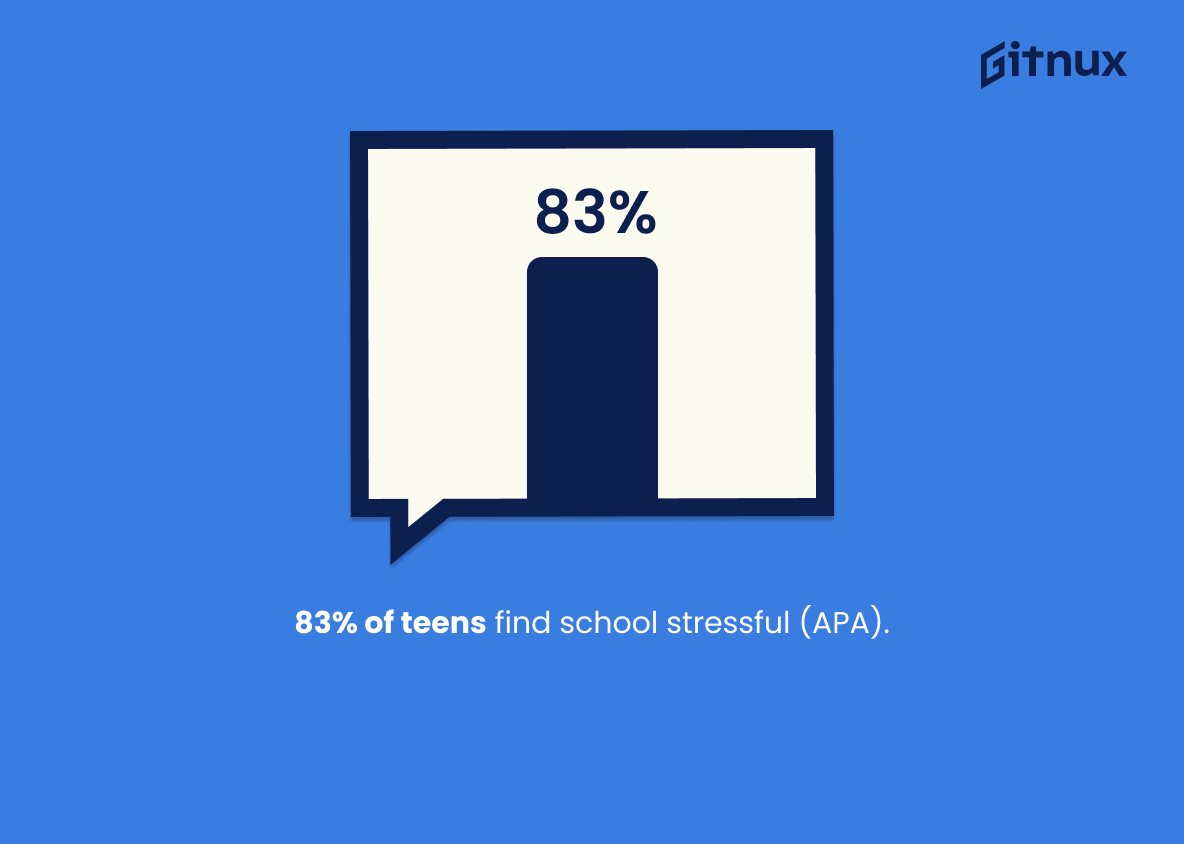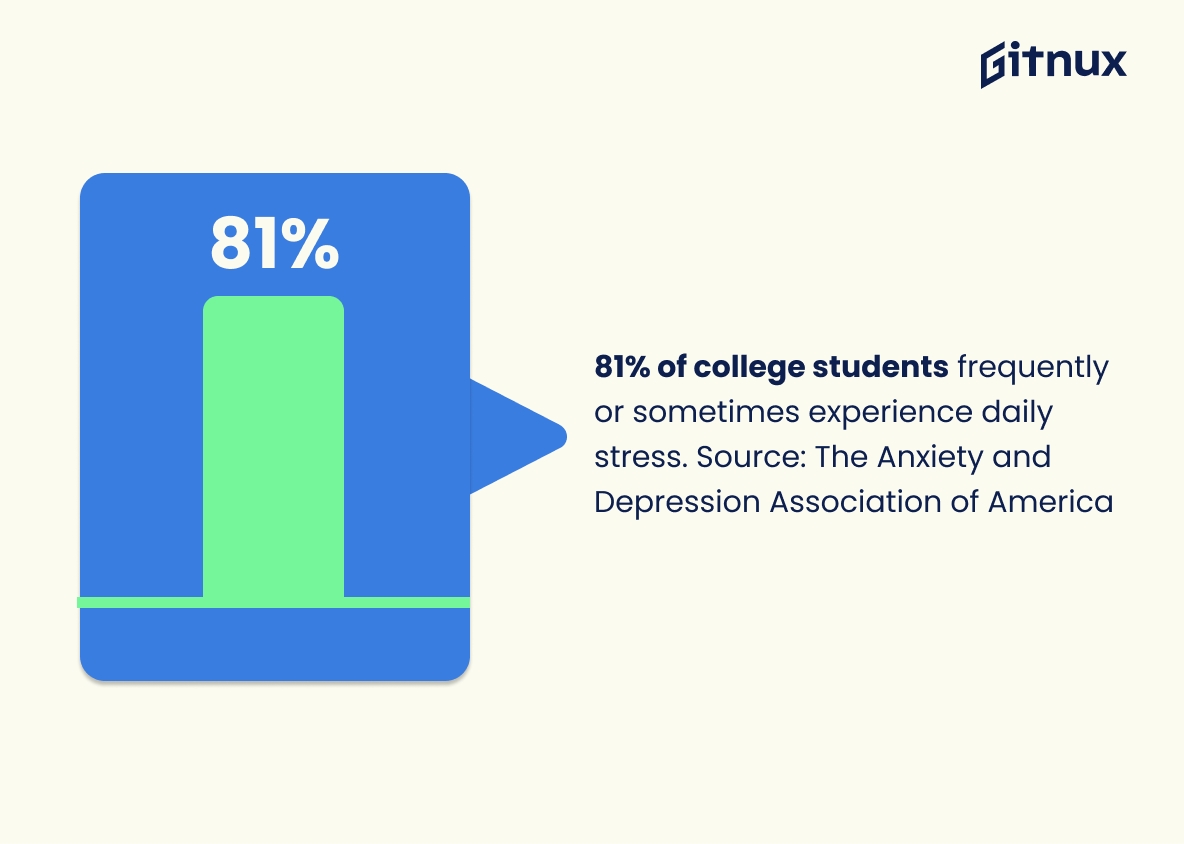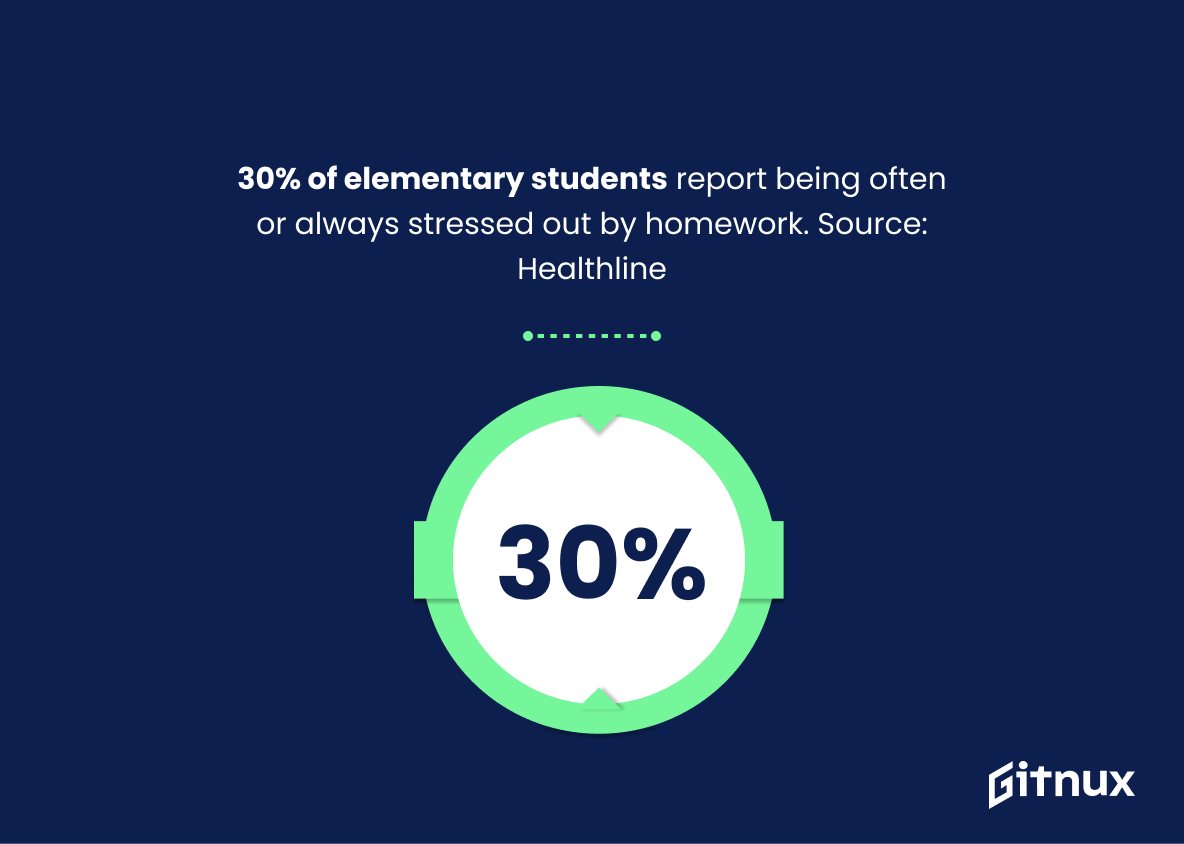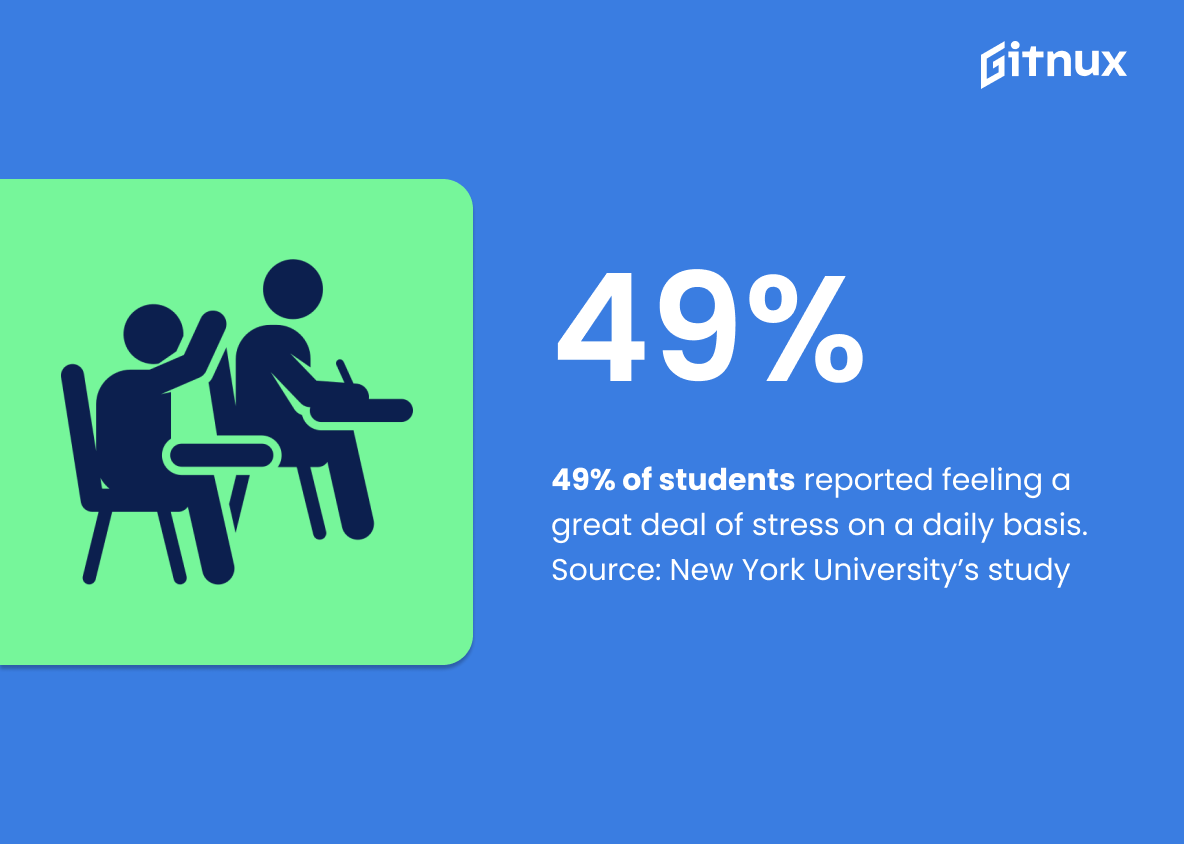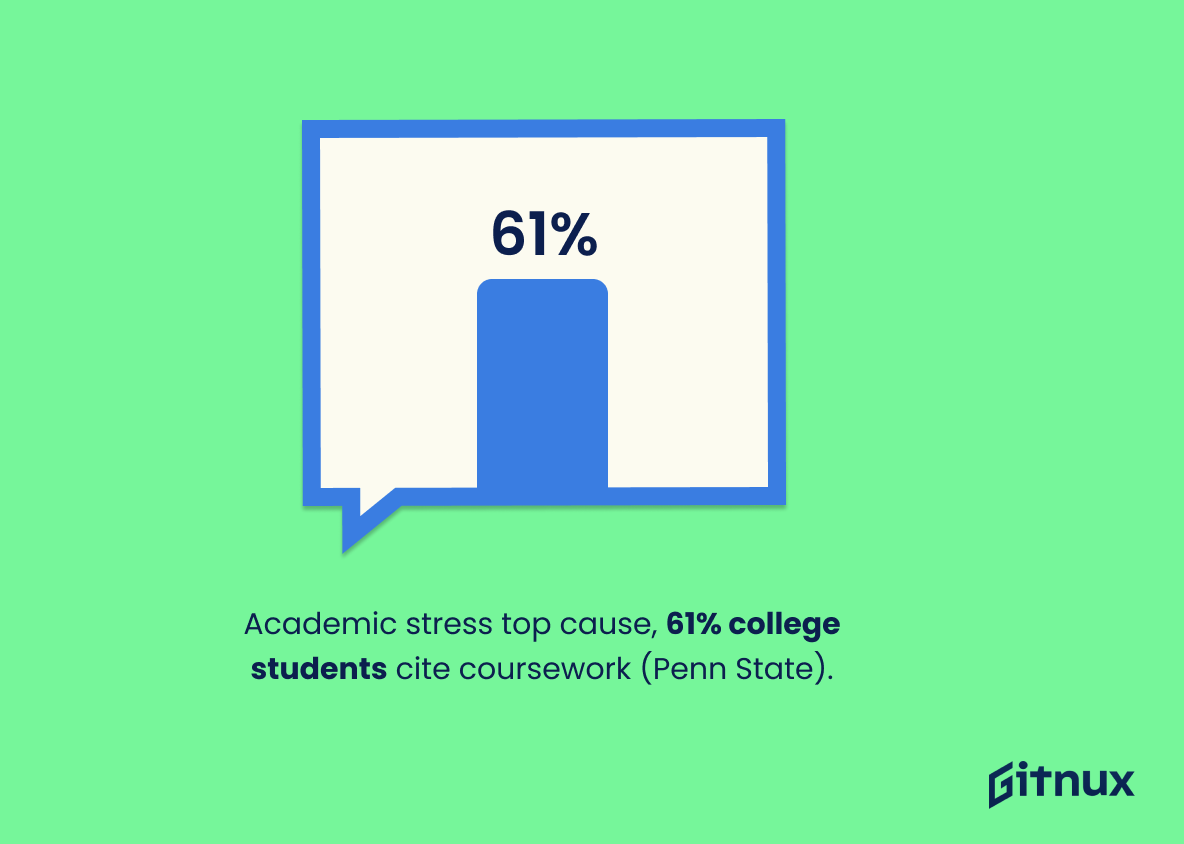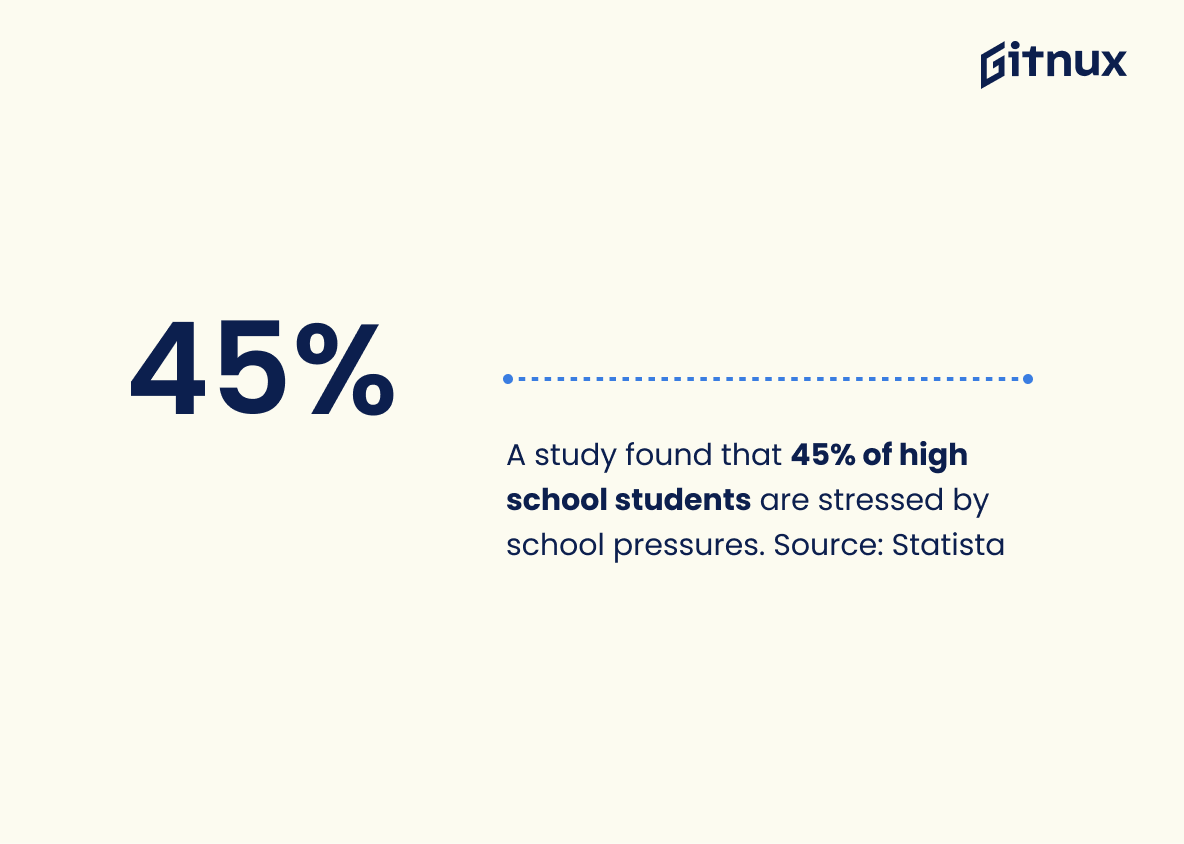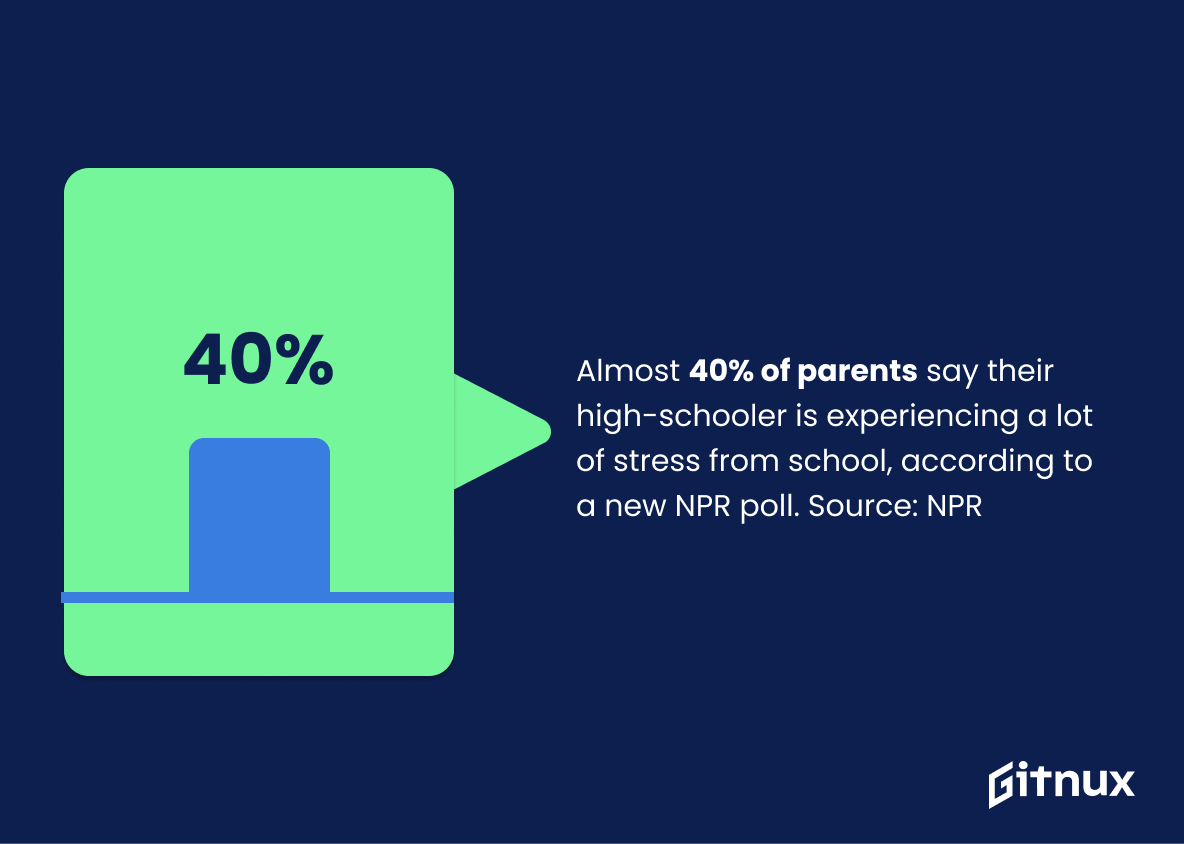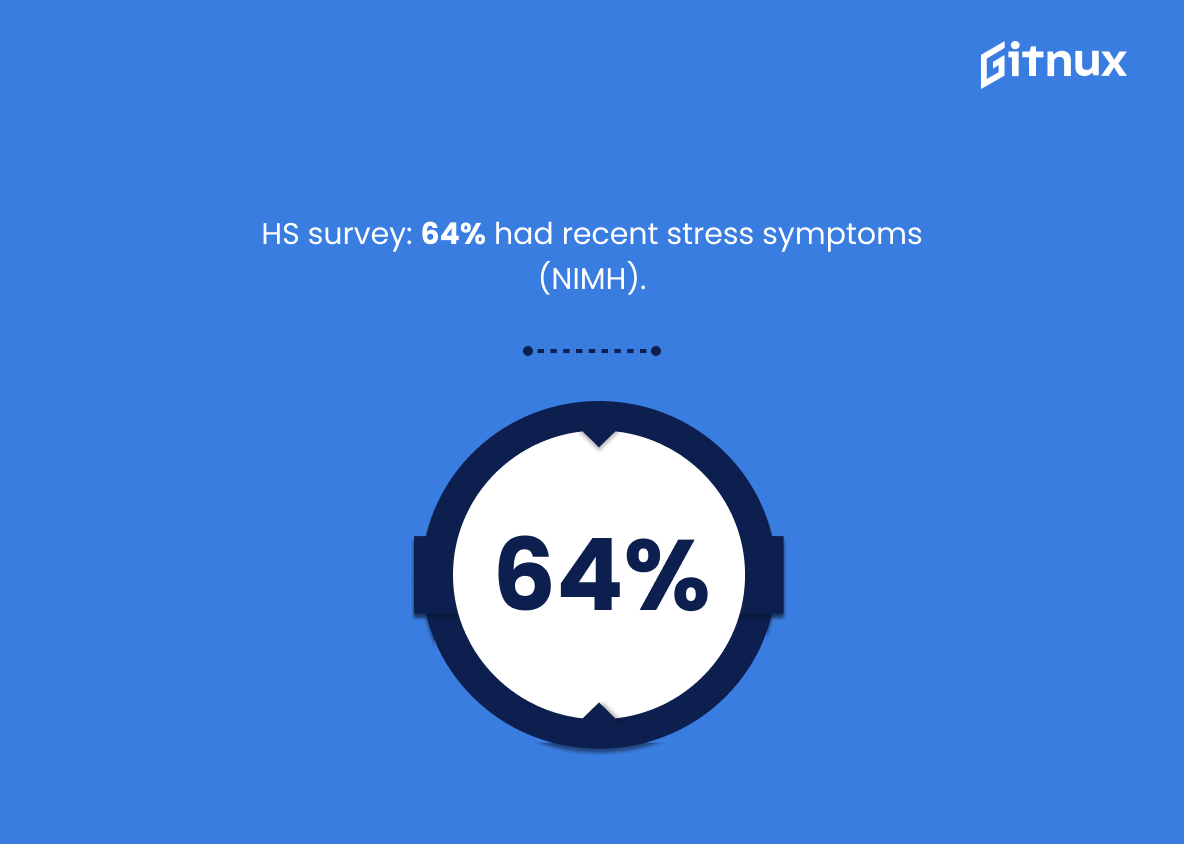Modern-day students are facing unprecedented levels of stress, transforming their educational journeys into daunting uphill climbs. The escalating pressure of acing exams, juggling extracurriculars, and meeting social expectations is posing severe challenges. Our today’s blog post dives deep into the grim world of school stress statistics, revealing the unseen pressure students carry within their backpacks.
We’ll untangle the complex web of figures, examining the correlation between mounting school stress and its adverse impacts on students’ mental and physical wellness. Join us as we shed light on this pressing issue, reflecting on key stats, potential triggers, and meaningful insights that can lead to constructive change and improved student well-being.
The Latest School Stress Statistics Unveiled
Roughly 1 in 3 students report feeling stressed-out all or most of the time due to school. Source: Pew Research Center
In the intricate tapestry of school stress statistics, the thread that “Roughly 1 in 3 students report feeling stressed-out all or most of the time due to school,” as reported by Pew Research Center, weaves a significant pattern. This revelation unravels a poignant image of the relentless pressure students are under; it’s the metaphorical elephant in the classroom. Occupying an immense space in the educational narrative, this data point is a wake-up call for education stakeholders, coaxing them to recognize the serious implications of full-time stress on the students’ mental health, academic performance, and overall wellbeing.
It’s a compelling evidence, showcasing the urgency to recalibrate educational systems, enabling them to nurture growth, resilience and potential rather than extracting toll in stress. Just as an architect builds upon a solid foundation, so should this statistic be used as a cornerstone in constructing a comprehensive understanding and developing solutions for school-related stress.
Nearly 83% of teens say that school is a significant source of stress in their life. Source: American Psychological Association
Highlighting the statistic from the American Psychological Association that nearly 83% of teens identify school as a significant source of stress, serves as a spotlit underline of an exigent issue. In the discourse of a blog post about school stress statistics, it illuminates the urgency of addressing academic-induced anxiety among adolescents.
As a principal talking point, it brings forth the pervasiveness of the problem, laying the foundation for engaging discussions about its causes, implications, and potential solutions for stress management in the school environment. This statistic also serves as an analytical tool to gauge the success of any interventions implemented, thus providing insights for educators, parents, and mental health professionals alike in their quest to alleviate student stress.
As a result of stress, 26% of students felt tired and 23% skipped a meal. Source: American Psychological Association
Highlighting these figures draws attention to the tangible effects of stress on students, giving us an eye-opening perspective on the detrimental crossroads of academic pressure and health. With over a quarter experiencing fatigue and nearly a quarter forgoing meals, this statistic amplifies the importance of addressing students’ stress levels.
It underscores the urgency for interventions, such as stress management initiatives or school policies, aimed at fostering healthier study environments. Furthermore, the data works as a prompt for further discussion on topics of student wellbeing and balanced lifestyle in the context of academic life, making it a pivotal point in the discourse of school stress statistics.
81% of college students frequently or sometimes experience daily stress. Source: The Anxiety and Depression Association of America
Highlighting the figure that 81% of college students frequently or sometimes experience daily stress, as identified by The Anxiety and Depression Association of America, offers a tangible evidence of the escalated stress levels amongst students in academic settings. In the narrative of a blog post about School Stress Statistics, this fact unveils the gravity of the problem, setting an agenda for discourse emphasizing the need for effective stress management strategies and mental health support in schools.
This statistic serves as a catalyst for conversation, helps in debunking the myth of stress-free college life, and reinforces the importance of mental health awareness, timely interventions and resources for students to help manage, if not alleviate, their daily stress.
30% of elementary students report being often or always stressed out by homework. Source: Healthline
Delving into the realm of school stress, one cannot overlook the revelation that a significant chunk, precisely 30%, of elementary students find themselves frequently drowning in a sea of homework-induced stress. This illuminating statistic, courteously provided by Healthline, delivers an incisive snapshot of our present education scenario.
Dwelling within the confines of a blog post about School Stress Statistics, this particular data tailors a new dimension. It breaks the assumption of stress being reserved exclusively for older students, indicating that educational stress starts earlier than one might typically assume. Serving as a potential wake-up call to educators, parents, and policy makers, it underscores the necessity to evolve current educational practices.
The fact that almost one-third of young learners are swimming against a tide of chronic stress provides an unvarnished incentive to promote healthier homework habits and sufficient leisure time for students, paving the way for a healthy learning environment.
49% of students reported feeling a great deal of stress on a daily basis. Source: New York University’s study
The topic of school stress reaches critical mass when considering New York University’s study, divulging a staggering 49% of students experiencing a high level of stress daily. Injecting this data into our blog emphasizes the gravity of the situation. It paints a vivid picture of almost half the student population grappling with stress, a term often underestimated, on an incessant basis.
It’s a compelling call to action for educators, parents, and policymakers to prioritize students’ mental well-being, given the substantial evidence of its prevalence. This revealing statistic could potentially drive a shift in perceptions of student stress levels and foster conversations towards effective solutions.
Academic pressure is the leading cause of stress among students, with 61% of college students seeking counselling attributing their stress to coursework. Source: Penn State University
The pearl of wisdom emerging from this stark statistic reflects the harsh reality lurking in our academic institutes. The figures, as unveiled by Penn State University, assert that a whopping 61% of college students compelled to seek counseling tie their stress knots to academic pressure. Illuminating the magnitude of the issue, this statistic is a wake-up call for educators, mental health professionals, and policy makers.
It underscores the urgency of introducing adaptive academic structures, investing in mental health resources, and fostering a supportive environment on campuses. Therefore, in our quest to decipher the complexities of school stress dynamics, this statistic serves as a crucial compass. Providing the wider perspective, it allows us to explore the distressing labyrinth of academic pressure and devise more effective strategies for student stress management.
A study found that 45% of high school students are stressed by school pressures. Source: Statista
Delving into the pivot of the blog post, the revelation that almost half of high school students are worn down by school pressures, as unearthed by Statista, amplifies the urgency to address the stress epidemic in schools. Residing at the core of the discussion, this stark figure of 45% exemplifies the magnitude of the issue, capturing our attention towards potentially unhealthy levels of stress being experienced by teens. Consequently, it sets the stage for an engaging discourse about school stress while underscoring the necessity for immediate action and effective strategies for stress management in the educational environment.
Almost 40% of parents say their high-schooler is experiencing a lot of stress from school, according to a new NPR poll. Source: NPR
The statistic underscores a growing concern in our education system seen through the lens of nearly 40% of parents acknowledging the palpable academic stress their high-school students endure, as per a recent poll by NPR. A headline in a blog post about School Stress Statistics, it serves as a powerful testament to the escalating burden of schooling on the mental health of students.
The extent of this stress is so vast that it permeates their homes, reaching the parents’ awareness and concern. This piece of data acts as a rallying cry for stakeholders in education to delve deeper into the roots of this problem, seek solutions, and alleviate the undue stress our young learners are battling.
A survey of high school students found that 64% reported experiencing symptoms of stress over the past month. Source: National Institute of Mental Health
Highlighting the survey finding from the National Institute of Mental Health that 64% of high school students reported symptoms of stress over the past month unveils a far-reaching issue within our educational system. This statistic paints a tangible picture of young minds grappling with stress, giving credence to the prevalent state of pressure within education environments. Knowledge of such compelling data can serve as a catalyst for much-needed conversations and measures to alleviate academic stress, ultimately fostering healthier learning spaces.
Furthermore, by understanding the magnitude of the issue, readers can appreciate the urgency of prioritizing and implementing solutions for stress management in schools. Consequently, this percentage ensures we not only recognize but also correctly address the scale of the problem. In a nutshell, this statistic provides a compelling argument for the need for actionable school stress management strategies.
Teachers report that the stress of school is significantly reducing the time they spend teaching. On average, they report losing 4 hours of instructional time a week due to stress. Source: American Federation of Teachers,
Drawing reference from the compelling figures provided by the American Federation of Teachers, it becomes starkly evident just how profound the impact of school-related stress has transcended mere mental pressures, delving deep into influencing instructional quality and time. Teachers reportedly lose an astonishing average of four instructional hours weekly due to stress. This revelation forms an integral cornerstone for any discourse related to school stress statistics.
Viewing this significant statistic through the lens of an academic ecosystem, we can see it paints a narrative of the covert impacts of stress, not only on teachers’ wellbeing but on the broader educational experience itself. This information has broad implications, shedding light on the unintended consequence of stress that might, in turn, detract from the overall quality of student education.
Moreover, it elucidates the critical need for strategic interventions designed to minimize school-related stress, thereby enhancing instructional effectiveness and teaching productivity. So, in the grand tapestry of a blog post about School Stress Statistics, this stat effectively threads the narrative, demanding readers’ attention, and spurring action within the educational community.
In a survey, 70% of teenagers characterized anxiety and depression as major problems among their peers, rating it higher than bullying, drug addiction, or drinking. Source: Pew Research Centre
Exposing the magnitude of anxiety and depression among teenagers, this startling statistic from the Pew Research Centre thrusts a critical issue into the spotlight. In a school setting beset with common issues like bullying, drug addiction, or drinking, it underscores that it’s the invisible battles within that are wreaking havoc the most.
A drawn disproportionate focus on anxiety and depression by 70% of teenagers surmises the enormity of school stress experienced by them. This insight could be the pivot point for a compelling school stress statistics blog, which doesn’t just aim to identify the problems teenagers face, but also calls for urgent action-informed by real-life statistics-to mitigate their plight.
80% of students reported being a lot more anxious and stressed about school than they were previously. Source: American School Counselor Association
The cascade of emotion that floods from reading the statistic ‘80% of students reported being a lot more anxious and stressed about school than they were previously’, as given by the American School Counselor Association, paints an alarming portrait of the current state of student mental health. In an analytical journey on school stress statistics, this nugget of information serves as a beacon, highlighting the surge in school-related anxiety and stress, an issue that cannot remain veiled any longer.
This alarming increase in stressed students is a critical marker, acting as a call to arms for everyone involved in the education process, be it parents, teachers, school administrators or mental health professionals. Hence, this data forms the spine to an insightful narrative that advocates for substantial changes in the education system, illustrating the undeniable reality and urgency of the stress phenomenon among students.
Among college students, 80% claim they frequently or sometimes experience daily stress. Source: The American Institute of Stress
In the realm of educational narratives, the aforementioned statistic serves as a sobering beacon highlighting the pressing issue of stress among college students. The revelation that 80% of college students, as reported by The American Institute of Stress, frequently or sometimes face daily stress signals towards an alarming educational landscape. These figures cease to be mere numbers; instead, they embody the silent screams of unwavering stress coursing through the veins of our college youth.
As we delve into this blog about School Stress Statistics, this statistic paints a vivid picture, setting the stage for a deep exploration into the causes, impacts, and possible alleviation strategies for this prevalent student stress. It sets a compelling and dire premise that underscores the importance of proactive action in addressing this educational concern, while ensuring that the readers are acutely aware of the gravity of this issue.
High school students who get less than 7 hours of sleep are more likely to say they have felt hopeless, seriously considered suicide, taken illegal drugs, and consumed alcohol. Source: RAND Corporation
In the realm of school stress statistics, the RAND Corporation’s findings shed a disturbing light on the deep-seated connection between lack of sleep and a host of negative consequences among high school students. Their research reveals that insufficient sleep among these adolescents can trigger an alarming labyrinth of hopelessness and thoughts of suicide, while also enticing them to traverse the dodgy roads of drug and alcohol abuse.
This underscores the necessity to bring the silent epidemic of sleep deprivation within our schooling environment to the fore and triggers a call to action for parents, educators, and stakeholders to reevaluate the importance of ensuring students achieve their necessary amount of sleep. This revelation also highlights the urgency of implementing comprehensive school-wide strategies to cope with stress. Understanding this statistic could be a crucial piece to the puzzle, opening a new frontier in mitigating school stress and establishing a healthier learning environment.
According to Stanford researchers, more than two hours of homework a night may be counterproductive. Source: Stanford News
Painting an illuminating snapshot in the canvas of school stress statistics, the Stanford study braids a compelling narrative. The research poses more than two hours of homework a night as potentially counterproductive. This revelation punctuates a significant issue often overlooked – the elevating pressure and consequent stress subjected upon students due to excessive homework.
By adding this Stanford discovery to our conversation about school stress, we deepen our understanding of the root causes of student strain. It prompts educators and parents alike to reassess, and perhaps redefine, the boundaries of academic workloads. This statistic ultimately underscores a critical standpoint, it waves a red flag over the potential harbingers of stress hidden in homework routines. The study calls for more than attention, it demands a critical action towards mitigating stress in the school environment.
Thus, in a broader perspective, this statistic unwraps an opportunity for transforming academic cultures, refining homework policies, and fostering a balanced, less stressful learning environment.
45% of teenagers say they’re stressed by school pressures. Source: CNBC
Discerning the profound implications of the statement that ‘45% of teenagers express schooling pressures as a source of stress, as reported by CNBC’, is fundamental in pondering school stress statistics. This noteworthy percentage underscores the alarming reality that nearly half of all teenagers are grappling with the weight of educational demands.
It offers poignant insight into the scale of school-related stress among teenagers, pulling into sharp focus the pressing need to address and alleviate school stressors. This nugget of numerical truth, therefore, serves as both an eye-opening revelation and a clarion call to action in our blog post discussion about School Stress Statistics.
According to the Centers for Disease Control and Prevention, only 20% of high school students get enough sleep. Source: CDC
Highlighting the statistic from the Centers for Disease Control and Prevention subtly underscores the intensity of the stress epidemic plaguing high school students. The insufficient sleep suffered by a staggering 80% of these individuals paints a stark picture of the nocturnal sacrifices made in the face of unrelenting academic pressure.
It silently echoes the magnitude of stress students are experiencing due to school-related responsibilities. Therefore, this insight provides a powerful conduit for gaining empathy and understanding, thereby amplifying the urgency and need for tangible solutions in the narrative of School Stress Statistics.
Stress and mental health issues are the leading factors affecting individual student performance, according to 30% of all faculty surveyed. Source: Inside Higher Ed
Unraveling the intriguing insight from Inside Higher Ed, an interesting link surfaces between stress, mental health issues, and individual student performance. Amplified by the collective viewpoint of 30% of faculty surveyed, we see compelling evidence suggesting these challenges may insidiously infiltrate the realm of academia, shadowing over a student’s potential. Such a statistic doesn’t merely underline an education-centric concern. It reverberates across broader societal spectrums, hinting at a growing need to address these silent infiltrators in the learning environment.
By highlighting this influential factor, our discussion on School Stress Statistics acquires a profound depth, reminding everyone of the profound interconnectedness of emotional health and academic success. Therefore, in a bid to foster proactive measures, our exploration of this quantified burden thrusts attention on the imperative for strategic interventions, building emotionally resilient students who perform not just within classrooms, but also beyond, in real-world stages.
Conclusion
In conclusion, the levels of stress students face in schools today are unprecedented, and the statistics reflected in this post only underscore the magnitude of this problem. The elevated rates of emotional exhaustion, anxiety, and even depression amongst students represent a clear call to action for parents, educators, and policymakers alike.
It is critical to forge a collective effort to mitigate these stress levels, implement effective coping strategies, and create healthier academic environments. Acknowledging these statistics on school stress is the first step towards understanding and improving student mental health and overall well-being in our schools.
References
0. – https://www.www.nyu.edu
1. – https://www.www.aft.org
2. – https://www.www.npr.org
3. – https://www.www.pewresearch.org
4. – https://www.www.healthline.com
5. – https://www.www.apa.org
6. – https://www.www.statista.com
7. – https://www.news.stanford.edu
8. – https://www.www.cdc.gov
9. – https://www.ccmh.psu.edu
10. – https://www.www.rand.org
11. – https://www.www.pewsocialtrends.org
12. – https://www.www.schoolcounselor.org
13. – https://www.www.cnbc.com
14. – https://www.www.insidehighered.com
15. – https://www.www.stress.org
16. – https://www.adaa.org
17. – https://www.www.nimh.nih.gov

